I vividly remember when I was learning Hindi in Varanasi in the early 1980s being fascinated by the bookstall outside the Lalita cinema in Bhelapura. In the evenings as the light poured from the foyer windows crowds would gather around the bookstall outside the cinema.
People would browse through what was new and what was on offer, and after hovering for a while pounce on a publication and snatch it up for a quite low price mostly, and then take it away to devour later. There were all sorts of publications on offer, mostly in Hindi, Bangla, and English but also in many other regional Indian languages. The biggest and glossiest publications were probably the broadsheet newspapers that hung like banners in my memory from the opened shutters of the stall. The most inconspicuous publications were perhaps certain mysterious, cellophane wrapped magazines and books kept secreted under the counters. But the ones that attracted me most were the books and magazines with brightly coloured covers that often stood in stacks on the main shelves easily accessible from the street. In truth that bookstall was just one of countless such stalls everywhere in Varanasi, and every town in India in those days, where seemingly endless supplies of pulp fiction were available to sate the unquenchable thirst of readers wishing to escape the hectic reality of urban life and its hustle and bustle all around the city.
Continue reading this review
I didn’t fully realize it then, but this was actually perhaps a turning point in North Indian print cultures. The repression of the Emergency had only recently been lifted from people’s shoulders when I arrived in India in September 1977 and everybody was exploring what was possible in this new era, poised between a glimpse of a totalitarian possibility for India and the promise of the possibility of a new dawn for freedom in India. Looking ba
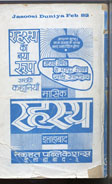
ck on the time, and the pulp fiction I bought over the following years, I have a strong sense that in a way it echoed the readers’ negotiations with modernity and how they could engage with the rapidly changing world around them.
One of the first publications I bought was the September 1982 edition of Jasusi Duniya published out of Allahabad which contained a story called Patthar ki Larki. Jasusi Duniya was a monthly magazine in Urdu and Hindi in which readers could read original Urdu novels by Ibn Safi, or their Hindi recreations (Friedlander 2015). The Hindi story was a rousing tale of the brave inspector Vinod and his sidekick and how they busted a racket. The plot pivoted on how a gang who were terrorizing a district by convincing them that their lair in the hills was the site of a supernatural spirit that could turn a person to stone. This reminded
me of earlier stories I had heard and read, in English, that also explored how the boundary between the supernatural and the criminal was not as clear at it might first seem. Perhaps since Edgar Alan Poe’s tales and Conan Doyle’s Hound of the Baskervilles this has been a consistent thread in mystery fiction. In a publication on Chandrakanta I have also explored how it’s the suspension in the readers’ mind of whether the story is really about the supernatural, or its rational explanation which has fascinated readers (Friedlander 2019). My sense is that readers were, and are, fascinated by the ways in which this relates to their own negotiation of their identity in re
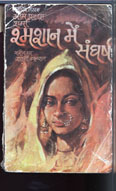
lation to tradition and modernity. This I believe is a key area in which pulp fiction has played a key role in negotiating modernity from the mid-nineteenth century onwards.
The borderline between fiction and reality also seemed to be very fluid in the pulp fiction I read from that same bookstall. I also bought, around the same time, a 1985 copy of Satya Katha. Despite being called true stories t
he way that it sensationally retold true crime stories was far more dramatic than factual and read largely as a gruesome parade of the kinds of atrocities and crimes that its reader would have been all too familiar with. I must admit I liked this genre much less than Jasusi stories. It was it seemed part of another negotiation with modernity, coming to terms with how people end up making dreadful mistakes when they are set adrift from life in traditional contexts and have to find a way to coexist with modern life in a world that does not seem to have a place for them.
Pulp fiction seemed to offer many more fascinating ways though for its readers to explore the new worlds they found themselves in, and another fascinating example was Shamshan me Sangarsh by the well-known author Om Prakash Sharma. My memory is this novel was based on the premise that a police department had been set up to stop crimes from ever happening due to the development of techniques to 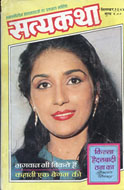 anticipate when a crime would occur. In this case the crime anticipated to be happening was in one of the countless towns of North India, and the special force was sent to the town to stop a crime taking place and as suggested by the title, involved a final showdown in a burning ground. One thing that fascinated me with this story was that it explored what must for many of its readers have been a topic of great interest. How did the police actually solve crimes, and did they have mysterious ways to do it which were not obvious, but actually effective? I say this also remembering that most people’s ordinary experiences of police investigative methods would have been very different. It is all very well having a police inspector as a hero, but how did that relate to ordinary people’s lives? I have a sense that for most people it was much more like the way that Inspector Matadeen behaved in Hari Shankar Parsai’s Inspector Matadeen on the Moon (1968) in which he satirically depicted how an Indian police inspector on a friendship mission to the moon unleashes a much more dangerous form of justice on an innocent public. There is also a nice translation of this, I seem to recall by CM Naim in the Gollancz Book of South Asian Science Fiction (2019).
anticipate when a crime would occur. In this case the crime anticipated to be happening was in one of the countless towns of North India, and the special force was sent to the town to stop a crime taking place and as suggested by the title, involved a final showdown in a burning ground. One thing that fascinated me with this story was that it explored what must for many of its readers have been a topic of great interest. How did the police actually solve crimes, and did they have mysterious ways to do it which were not obvious, but actually effective? I say this also remembering that most people’s ordinary experiences of police investigative methods would have been very different. It is all very well having a police inspector as a hero, but how did that relate to ordinary people’s lives? I have a sense that for most people it was much more like the way that Inspector Matadeen behaved in Hari Shankar Parsai’s Inspector Matadeen on the Moon (1968) in which he satirically depicted how an Indian police inspector on a friendship mission to the moon unleashes a much more dangerous form of justice on an innocent public. There is also a nice translation of this, I seem to recall by CM Naim in the Gollancz Book of South Asian Science Fiction (2019).
 There were also many books which I read which explored much more directly the interaction between the supernatural and crime. To my eternal regret I lost one like this which I bought at a Wheelers Book stall on the railway station in Varanasi and read on a seemingly endless trip to Mumbai. I can’t remember the author’s name or even the title, but the contents stick in my mind to this day. It was about a team of thieves who hatch a scheme to steal the treasures from a Naag deity that is passing itself off as an ordinary person living a quiet life in a small seaside town on an island off the western shore of India. However, their remarkable discovery that Naag deities are now passing themselves off as normal people, has missed a vital point, the detectives in the island’s police force are also Naag deities pretending to be human. So, it ended up a very odd procedural police story in which the police and victims are shape shifting spirits hunting down modern humdrum hoods.
There were also many books which I read which explored much more directly the interaction between the supernatural and crime. To my eternal regret I lost one like this which I bought at a Wheelers Book stall on the railway station in Varanasi and read on a seemingly endless trip to Mumbai. I can’t remember the author’s name or even the title, but the contents stick in my mind to this day. It was about a team of thieves who hatch a scheme to steal the treasures from a Naag deity that is passing itself off as an ordinary person living a quiet life in a small seaside town on an island off the western shore of India. However, their remarkable discovery that Naag deities are now passing themselves off as normal people, has missed a vital point, the detectives in the island’s police force are also Naag deities pretending to be human. So, it ended up a very odd procedural police story in which the police and victims are shape shifting spirits hunting down modern humdrum hoods.
The figure of the jasus, detective, in these pulp fiction novels was also very fluid, and the boundaries between the supernatural and the natural, and the detective and the spy were often not at all clear. Even authors and heroes were sometimes conflated, and I found myself reading books about Mona Darling, detective, superspy and defender of India, which were credited to the authorship of Mona Darling herself. Of course, this probably reflected more the way that the pulp industry in places such as Kanpur, Meerut and Delhi employed endless ghost writers to churn out the endless novels which sold so well in India during this period.
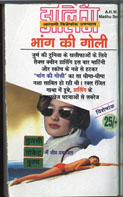 However, this era of Hindi pulp fiction was in truth drawing to a conclusion before my eyes. By the time I wrote an article about it (Friedlander 2015) it had actually almost come to an end as the economic model that underwrote it, mass purchase of print media had been replaced by the consumption of digital media. However, the role of pulp fiction from the mid-nineteenth century to the end of the twentieth century was a vital thread in how India, and the world, negotiated modernity. Pulp fiction offered individual readers a way to explore in their downtime by night or just while they took a break wherever they were, how they could relate the lives they were living to the new worlds they encountered as India rapidly modernized around them.
However, this era of Hindi pulp fiction was in truth drawing to a conclusion before my eyes. By the time I wrote an article about it (Friedlander 2015) it had actually almost come to an end as the economic model that underwrote it, mass purchase of print media had been replaced by the consumption of digital media. However, the role of pulp fiction from the mid-nineteenth century to the end of the twentieth century was a vital thread in how India, and the world, negotiated modernity. Pulp fiction offered individual readers a way to explore in their downtime by night or just while they took a break wherever they were, how they could relate the lives they were living to the new worlds they encountered as India rapidly modernized around them.
References
2019. ‘Candrakanta and the Epic of Loriki’. In Sharma, G. ed. Issues in Modern Hindi Literature. Munich: LINCOM.
2015, ‘Hindi Detective Pulp Fiction’ in Situations: Cultural Studies in the Asian Context, Vol. 8. 2 (2015), 27-47.
Safī, I. (1982), Jasusi Duniya, (343rd monthly issue): Pathar ki Larki, Ilahabad: Nakahat Pablikesans.
Darling, Mona (nd) Kali Mirch, A.H.W. Madhu Series. Tulsi Pocket Books.
Peter Friedlander is Associate Professor of Hindi at the Australian National University, Canberra.

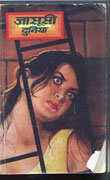
Very interesting subject, regards for putting up.Raise your business